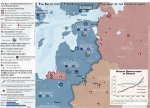Map. The Baltic States : from the periphery to the centre of the European strategic debate
Par , , le 25 septembre 2025.
Philippe Perchoc Head of the IRSEM Europe branch. He holds a PhD in political science from the Institut d’Etudes Politiques de Paris, where he wrote his thesis on Baltic foreign and defense policies after the collapse of the USSR. His work focuses on the place of the Baltic States in the European system in strategic, institutional and symbolic terms. He has just published : Philippe Perchoc, Estonie, Lettonie, Lituanie : de la périphérie au centre du débat stratégique européen, Étude 125, IRSEM, juin 2025.
Design of the map : AB Pictoris. AB Pictoris is a young French company founded by Blanche Lambert, an independent cartographer. Passionate about cartography and geopolitics, she obtained a Master’s degree in Geopolitics (cyber course, IFG, Paris VIII) and in Geostrategy (Sciences Po Aix) after a degree in Geography and Regional Planning (Paris I).
This annotated map underscores the critical role of the Baltic states for both the EU and NATO in shaping a coordinated response to Russian and Belarusian threats, reinforcing European security, and advancing the transformation of NATO and EU structures. The map is drawn from the study : Philippe Perchoc, Estonie, Lettonie, Lituanie : de la périphérie au centre du débat stratégique européen, Étude 125, IRSEM, juin 2025.
ESTONIA, Latvia, and Lithuania have long remained on the fringes of West European strategic concerns. Today, these three republics are on the frontline between the European Union and NATO on one side, and Russia and Belarus on the other. At the same time, they have gained strategic importance, seizing some of the most-desired positions in Brussels : that of High Representative of the Union for Foreign Affairs and Security Policy, held by the Estonian Kaja Kallas and that of Defense commissioner, held by Andrius Kubilius.
The commentary of this map allows to introduce this shift in its geographical dimension.
I. A frontline before the Russia-Belarus bloc
Estonia, Latvia, and Lithuania form together a European peninsula connected to the rest of Europe by the border between Poland and Lithuania, known as the Suwałki corridor. Contrary to the common thought, they are not “small countries”, as they cover all together the equivalent of twice Portugal’s size, yet with half of its population. Thus, the three Baltic nations are extensive in area, flat in terms of altitude (less than the Eiffel Tour with its aerials) and relatively sparsely populated. This creates numerous strategic dilemmas.
Their Russian and Belarusian neighbours border them simultaneously : to the east via Estonia and Latvia, and to the east, south, and west in the case of Lithuania. The alliance between Moscow and Minsk is also problematic for the Baltic states, as it nearly doubles Russia’s contact surface with NATO : 917 kilometres via Russia and 801 via Belarus.
Additionally, there is an important Russian-speaking population (22% in Estonia, 23 in Latvia and 5 in Lithuania), which is targeted by Russian propaganda and exploited in narratives aimed at destabilising the Baltic republics.
II. Strengthening the protection offered by the allies
In 2004, Estonia, Latvia and Lithuania were the only former Soviet republics to become member of NATO, and subsequently of the EU. Nevertheless, it took time for the level of protection provided by these organizations to increase, in correlation with Moscow’s steadily growing pressure on the region.
Starting from 2008 and the war between Russia and Georgia, the Baltic states became alarmed by Moscow’s aggressive behaviour toward its neighbours. Since 2004, NATO has provided air policing for the Baltic states, but they have considered these measures needed to be reinforced.
In the meantime, they made sure, sometimes against the prevailing mood, to join all European clubs : Schengen, eurozone. This strategy aimed at demonstrating their solidarity to benefit, in return, from the solidarity of the other Europeans.
After the invasion of Crimea in 2014, NATO recognised the need to strengthen its eastern flank, thus investing in an enhanced forward presence, and sending NATO troops to fortify temporarily the conventional deterrence in the region. The United Kingdom became a framework nation for Estonia, Canada for Latvia, and Germany for Lithuania (with France fulfilling this role for Romania). It also included a new airbase in Estonia and Lithuania, used for air policing.
III. At the heart of the regional strategic transformations
The regional strategic situation has been deeply transformed by the war in Ukraine. The latter has prompted Lithuania to limit transports toward Kaliningrad, thus forcing Russia to use maritime routes for its militarisation effort in the enclave, increasing military traffic in the Baltic Sea. In addition, the entire Baltic Sea has been affected by the rising tensions : increased military traffic and hybrid attacks on infrastructures, particularly cables.
The rising tensions led Finland and Sweden to abandon their neutrality to join NATO, both strengthening the alliance’s presence and requiring the rethinking of its defence plan for the region.
At the same time, the Baltic states must face the need to rethink their defence model, largely based on NATO and their specific relationship with the United States, in a context of American disengagement. They now view in a more favourable way European advances in the field of defence, particularly since the key positions held by the Estonian Kaja Kallas and the Lithuanian Andrius Kubilius. They are investing massively in their military equipment, exceeding 2,5% of their GDP and moving toward 4 or 5%.
Finally, this map illustrates the vital role the Baltic states play today for both the EU and NATO in providing a common response to the Russian and Belarusian threat, in reinforcing European security, and in transforming the EU’s and NATO’s apparatus.
Copyright for the comment September 2025-Perchoc/Diploweb.com
Plus
 |
Titre du document : Map. The Baltic States : from the periphery to the hearth of the European strategic debate This map is taken from : Philippe Perchoc, Estonie, Lettonie, Lituanie : de la périphérie au centre du débat stratégique européen, Étude 125, IRSEM, juin 2025. Document ajouté le 24 septembre 2025 Document JPEG ; 458824 ko Taille : 1200 x 867 px Visualiser le document |
This annotated map underscores the critical role of the Baltic states for both the EU and NATO in shaping a coordinated response to Russian and Belarusian threats, reinforcing European security, and advancing the transformation of NATO and EU structures.
Mots clés — Key words
NATO , Russia , European Union , Map , Geopolitics , Strategy , Estonia , Lithuania , LatviaPour ne rien rater de nos nouvelles publications, abonnez-vous à la Lettre du Diploweb !
Direction

Directeur, P. Verluise
Conseil scientifique
Mentoring et coaching géopolitique
Présenter le Diploweb.com
Charte du site
Auteurs
Proposer un article
Retrouvez la chaîne Diploweb sur :








